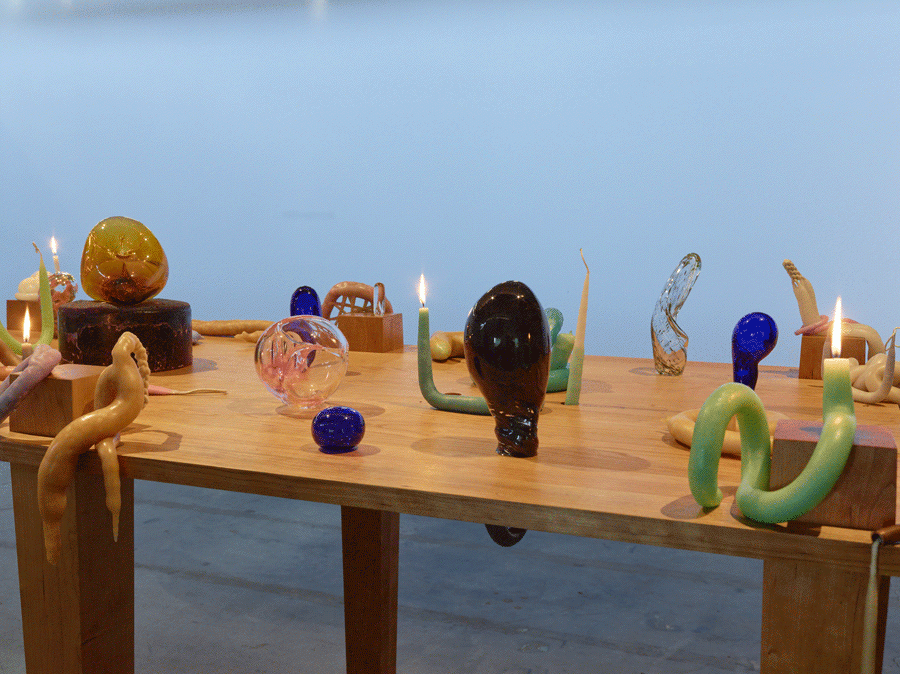Ghebaly Gallery, Los Angeles, 12 November – 23 December 2016
The presence of a pockmarked steel lump, about the size of a pomegranate, is immediately apparent upon entering Kelly Akashi’s solo exhibition. Positioned around head-height in a window cut into the gallery wall, this piece was cast from a ‘Sumo’ citrus, according to the press release. Also known as dekopon in Japan and hallabong in Korea, this hybrid fruit was invented by a Japanese farmer during the 1970s in an attempt to combine the sweetness of California oranges with the easy-peel qualities of the Japanese satsuma. Titled Be Me (Japanese-Californian Citrus) (all works 2016), the hybrid origins of this sculpture serve as a metaphor for Akashi’s Japanese-American heritage, and it turns out to be one of many proxies for the artist in the exhibition.
Indeed, the first thing that visitors to Being as a Thing will encounter is the artist’s own hands, cast in bronze and hung from two lengths of rope at the entrance to the exhibition. With their distinctive nails and (presumably) unique fingerprints, the hands of At Rest connote Akashi’s physicality, despite being detached from their owner. This motif recurs in the next, sparsely populated space, one of two galleries in the exhibition, where several bronze digits dangle from Finger Figure. In this configuration, comprising two interlocking circles tied with thread and recalling the form of a Native American dreamweaver, the artist’s hands acquire a more mystical resonance.
In the same room, six small photograms are enclosed in walnut frames. These works depict rounded, embryonic forms, which appear phosphorescent against muddy green, brown and black backgrounds. With their glowing membranes, the mysterious shapes suggest both microscopic cells and cosmic-scaled solar systems. They were created by placing blown-glass objects on photographic paper before exposing them to light. These works evoke biological processes that have been artificially engineered.
Many of the assemblages resemble the aftermath of some pagan spell, and the proliferation of ritualistic references summons up connotations of occult practices
The blown-glass pieces used to make them reappear in the second, dimly lit gallery, arrayed across the Arrangement sculptures, a series of tablelike structures made from cherrywood and decked with bulbous glass orbs, plant matter, fingernails and candles in various stages of use. With these works, Akashi exploits the myriad aesthetic possibilities of candlewax – see the sludgy puddles dripping down the legs of Activity Table, the thick, melted phallic stems oozing across its top and carefully-looped intestinal brown coils resting on its box stretcher. The wall above Wall Candle (Tentacle) is blackened with scorch marks, and wax drips down to a mound of ash on the floor below, the aftermath of a candle-lighting performance by the artist on the show’s opening night. The air is heavy with the smell of wax.
Bursting with quasi-organic matter, the works in Being as a Thing have been deftly manipulated, moulded and shaped by Akashi to resemble a self-contained ecosystem, subject to its own logic of entropy and homeostasis. On the one hand, the candle works are ephemeral, whereas others, like Tall Weed, a slender bronze plant with delicately veined leaves, appear to arrest time. The glass elements in the Arrangement series, which were hand-blown by the artist, capture her breath and give it permanent form. Yet to what ends? Many of the assemblages of Being as a Thing resemble the aftermath of some pagan spell, and the proliferation of ritualistic references summons up connotations of occult practices. Akashi is clearly interested in symbolism, conjuring up her own presence almost everywhere one looks, from the casts of her fingers to the innocuous little Sumo citrus. However, her imbuing of inanimate matter with vitality feels more like a demonstration of her own alchemical virtuosity than a profound enquiry into the nature of things.
From the January and February 2017 issue of ArtReview.
